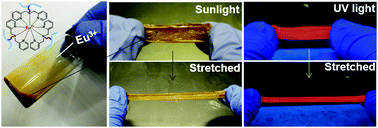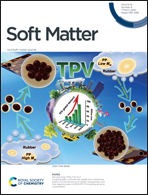Adaptable Eu-containing polymeric films with dynamic control of mechanical properties in response to moisture†
Abstract
Self-healing polymers often have a trade-off between healing efficiency and mechanical stiffness. Stiff polymers that sacrifice their chain mobility are slow to repair upon mechanical failure. We herein report adaptable polymer films with dynamically moisture-controlled mechanical and optical properties, therefore having tunable self-healing efficiency. The design of the polymer film is based on the coordination of europium (Eu) with dipicolylamine (DPA)-containing random copolymers of poly(n-butyl acrylate-co-2-hydroxy-3-dipicolylamino methacrylate) (P(nBA-co-GMADPA)). The Eu–DPA complexation results in the formation of mechanically robust polymer films. The coordination of Eu–DPA has proven to be moisture-switchable given the preferential coordination of lanthanide metals to O over N, using nuclear magnetic resonance and fluorescence spectroscopy. Water competing with DPA to bind Eu3+ ions can weaken the cross-linking networks formed by Eu–DPA coordination, leading to the increase of chain mobility. The in situ dynamic mechanical analysis and ex situ rheological studies confirm that the viscofluid and the elastic solid states of Eu-polymers are switchable by moisture. Water speeds up the self-healing of the polymer film by roughly 100 times; while it can be removed after healing to recover the original mechanical stiffness of polymers.

- This article is part of the themed collection: Soft Matter Most Popular 2020


 Please wait while we load your content...
Please wait while we load your content...
